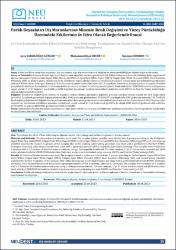| dc.contributor.author | Güngör, Ayça Sarıalioğlu | |
| dc.contributor.author | Örcün, Muhammet Enes | |
| dc.contributor.author | Dönmez, Nazmiye | |
| dc.date.accessioned | 2023-11-13T09:54:49Z | |
| dc.date.available | 2023-11-13T09:54:49Z | |
| dc.date.issued | 2023 | en_US |
| dc.identifier.citation | SARIALİOĞLU GÜNGÖR, A., ÖRCÜN, M. E., & DÖNMEZ, N. (2023). Farklı Beyazlatıcı Diş Macunlarının Minenin Renk Değişimi ve Yüzey Pürüzlülüğü Üzerindeki Etkilerinin İn Vitro Olarak Değerlendirilmesi. Necmettin Erbakan Universitesi Dis Hekimligi Dergisi (NEU Dent J), Necmettin Erbakan. https://doi.org/10.51122/neudentj.2023.55 | en_US |
| dc.identifier.uri | http://dx.doi.org/10.51122/neudentj.2023.55 | |
| dc.identifier.uri | https://hdl.handle.net/20.500.12941/166 | |
| dc.description.abstract | Amaç: Farklı içeriklere sahip dört beyazlatıcı diş macununun sığır dişi minesinin renk değişimi ve yüzey pürüzlülüğüne etkisini değerlendirmektir. Gereç ve Yöntemler: Çalışma, 40 adet sığır kesici dişinin mine yüzeyleri üzerinde gerçekleştirildi. Kahve solüsyonunda renklendirilmiş dişler uygulanacak diş macununa göre 5 gruba ayrıldı: Signal White Now Gold (WNG), Colgate Optic White Expert (OWE), Colgate Optic White Charcoal (OWC), Rocs Sensation Whitening (SW) ve Kontrol grubu (distile su) (n=8). Örneklerin renklendirme sonrası ve fırçalama prosedürü sonrası yüzey pürüzlülükleri profilometre (MarSurf M300C, Mahr, Gottingen, Almanya) cihazı ile, renk ölçümleri spektrofotometre (VITA Easyshade, Zahnfabrik, Almanya) cihazı ile yapıldı. Örnekler şarj edilebilir diş fırçası kullanılarak 1:3 oranında distile su +macun karışımı ile 5 dk boyunca fırçalandı. Renk analizinde CIEDE2000 renk formülasyonuna uygun olarak L*, a*, b* değerleri kaydedildi ve ∆E00 değerleri hesaplandı. Verilerin istatistiksel analizi tek yönlü ANOVA ve Post hoc Tukey testleri kullanılarak değerlendirildi (p<0.05). Bulgular: Örneklerin renklendirme sonrası ve fırçalama sonrası ölçülen pürüzlülük değerleri arasında istatiksel olarak anlamlı bir fark tespit edildi (p<0.001). En yüksek pürüzlülük değişim yüzdesi (ΔRa) WNG grubunda gözlenirken (-55.16±3.77), en düşük ΔRa OWC grubunda bulundu (-39.73±8.84). Renk değişimi değerlendirildiğinde tüm beyazlatma macunları ile kontrol grubu arasında istatistiksel olarak anlamlı fark bulundu (p=0.004). Diş macunları arasında ise beyazlatma etkinlikleri açısından istatistiksel olarak anlamlı bir fark bulunmadı (p>0.05). En düşük ΔE00 Kontrol grubunda elde edilirken (2.74±0.09), en yüksek ΔE00 OWC grubunda görüldü (5.4±0.88). Sonuç: Çalışmada kullanılan beyazlatıcı diş macunları sığır dişlerinin mine yüzey pürüzlülüklerinde azalmaya sebep olmuş ve tüm gruplarda kayda değer bir beyazlatma elde edilmiştir. | en_US |
| dc.description.abstract | Aim: To evaluate the effect of four whitening toothpastes on the color change and surface roughness of bovine enamel. Material and Methods: 40 extracted bovine incisors were used. The samples stained in coffee were divided into 5 groups according to the toothpaste: Signal White Now Gold (WNG), Colgate Optic White Expert (OWE), Colgate Optic White Charcoal (OWC), Rocs Sensation Whitening (SW), and control group (distilled water)(n=8). Surface roughness of the samples after coffee staining and brushing procedure was done with a profilometer (MarSurf M300C, Gottingen, Germany), color measurements were made with a spectrophotometer (VITA Easyshade, Zahnfabrik, Germany). The samples were brushed for 5 minutes with a 1:3 mixture of distilled water+toothpaste using a rechargeable toothbrush. For color analysis, L*,a*,b* values were recorded and ∆E00 were calculated with the CIEDE2000 formulation. Statistical analysis were evaluated using one-way ANOVA and Post hoc Tukey tests (p<0.05). Results: 40 extracted bovine incisors were used. The samples stained in coffee were divided into 5 groups according to the toothpaste: Signal White Now Gold (WNG), Colgate Optic White Expert (OWE), Colgate Optic White Charcoal (OWC), Rocs Sensation Whitening (SW), and control group (distilled water)(n=8). Surface roughness of the samples after coffee staining and brushing procedure was done with a profilometer (MarSurf M300C, Gottingen, Germany), color measurements were made with a spectrophotometer (VITA Easyshade, Zahnfabrik, Germany). The samples were brushed for 5 minutes with a 1:3 mixture of distilled water+toothpaste using a rechargeable toothbrush. For color analysis, L*,a*,b* values were recorded and ∆E00 were calculated with the CIEDE2000 formulation. Statistical analysis were evaluated using one-way ANOVA and Post hoc Tukey tests (p<0.05). Conclusion: All the whitening toothpastes tested in the study caused a decrease in the surface roughness of bovine enamel and a remarkable whitening was obtained in all groups. | en_US |
| dc.language.iso | tur | en_US |
| dc.publisher | Dergi Park | en_US |
| dc.relation.isversionof | 10.51122/neudentj.2023.55 | en_US |
| dc.rights | info:eu-repo/semantics/openAccess | en_US |
| dc.subject | Beyazlatıcı diş macunu | en_US |
| dc.subject | Yüzey pürüzlülüğü | en_US |
| dc.subject | Renk değişimi | en_US |
| dc.subject | CIEDE2000 | en_US |
| dc.subject | Mine | en_US |
| dc.subject | Whitening toothpaste | en_US |
| dc.subject | Surface roughness | en_US |
| dc.subject | Color change | en_US |
| dc.subject | Enamel | en_US |
| dc.title | Farklı beyazlatıcı diş macunlarının minenin renk değişimi ve yüzey pürüzlülüğü üzerindeki etkilerinin in vitro olarak değerlendirilmesi | en_US |
| dc.title.alternative | In vitro evaluation of the effect of commercial whitening toothpastes on enamel color change and the surface roughness | en_US |
| dc.type | article | en_US |
| dc.authorid | Ayça Sarıalioğlu Güngör / 0000-0002-8779-2949 | en_US |
| dc.department | Fakülteler, Diş Hekimliği Fakültesi, Klinik Bilimler Bölümü | en_US |
| dc.contributor.institutionauthor | Güngör, Ayça Sarıalioğlu | |
| dc.identifier.volume | 5 | en_US |
| dc.identifier.issue | 1 | en_US |
| dc.identifier.startpage | 25 | en_US |
| dc.identifier.endpage | 34 | en_US |
| dc.relation.journal | Necmettin Erbakan Üniversitesi Diş Hekimliği Dergisi | en_US |
| dc.relation.publicationcategory | Makale - Uluslararası Hakemli Dergi - Kurum Öğretim Elemanı | en_US |

















